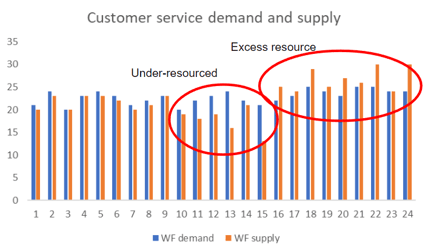I'm writing this sitting on a bus on the fairly new E18 highway. It's a really nice highway - not a single pothole, it has digital speed signs and the geometry is smooth.
So of course my optimizer mind thought this is way too good! Someone's had far too much resources on their hands. Which led me to think that optimizing a set of things, (like roads, work shifts, routes) usually leads to mediocrity by averaging out.
Bear with me a moment.
Over-quality and under-quality are both errors.
It's obvious why delivering too low quality is an error. Overly high quality is equally bad, because that means the resources could have been better spent somewhere else. In the context of highways the (very much simplified) setting would be that the road authority wants to maximize safety and has a fixed budget to do so.
Roads are in varying condition and the better the condition, the higher the safety metric. Since investments mostly have diminishing returns, it's probable that improving the worst roads is going to have a larger impact than polishing the best roads further.
This would lead there to be an "optimal" road condition with any given budget, which all roads would then regress towards.
However, this isn't, what happens, why?
I chose a really bad example that's why, but anyway…
The road condition needs of course to be weighted with the amount of traffic to have any sensible bearing to safety. Nobody cares about some random forest road where two tractors drive each year.
With this in mind I can enjoy the smooth E18 without cognitive dissonance. The general point still holds though. If two roads have the same amount of traffic they should have similar repair budgets and condition, ceteris paribus - with other things being equal.
Let’s give a couple of better examples.
In customer service a long waiting time equals bad service (there are also more interesting ways to deliver bad service, but that's outside our scope this time, although would be fun to vent about).
To reduce waiting times more customer representatives need to serve customers. Unless more customer representatives are employed, it means that waiting times need to be prolonged somewhere else.
The worst situation is one where a part of the time representatives are idle and another time queues accumulate. The best situation is one with an equal waiting time at all times.
Then the organization is running at capacity and the only way to improve (resource planning -wise) is to employ more staff.

Figure 1: Workforce demand and supply
The same holds true for an organization with a vehicle fleet, e.g. delivery service or waste management. There’s a tradeoff between probability of being late or causing overtime on routes and meeting all delivery targets & time-window requirements.
Overperforming on one metric such as being on time with one vehicle means other vehicles have a harder time meeting their targets. One way out is to monetize the metrics or set a certain service level requirement and plan all routes simultaneously, so the whole fleet operates at a similar level.
To summarize, in planning, mediocrity (or homogeneous quality if you want to sound fancier), is what one should strive for. When considering an ensemble of objects, equal quality is the overall-quality maximizing tactic.
